2013 NISSAN VERSA phone
[x] Cancel search: phonePage 206 of 331

MEMO
Display screen, heater, air conditioner, audio and phone systems4-69
Page 220 of 331
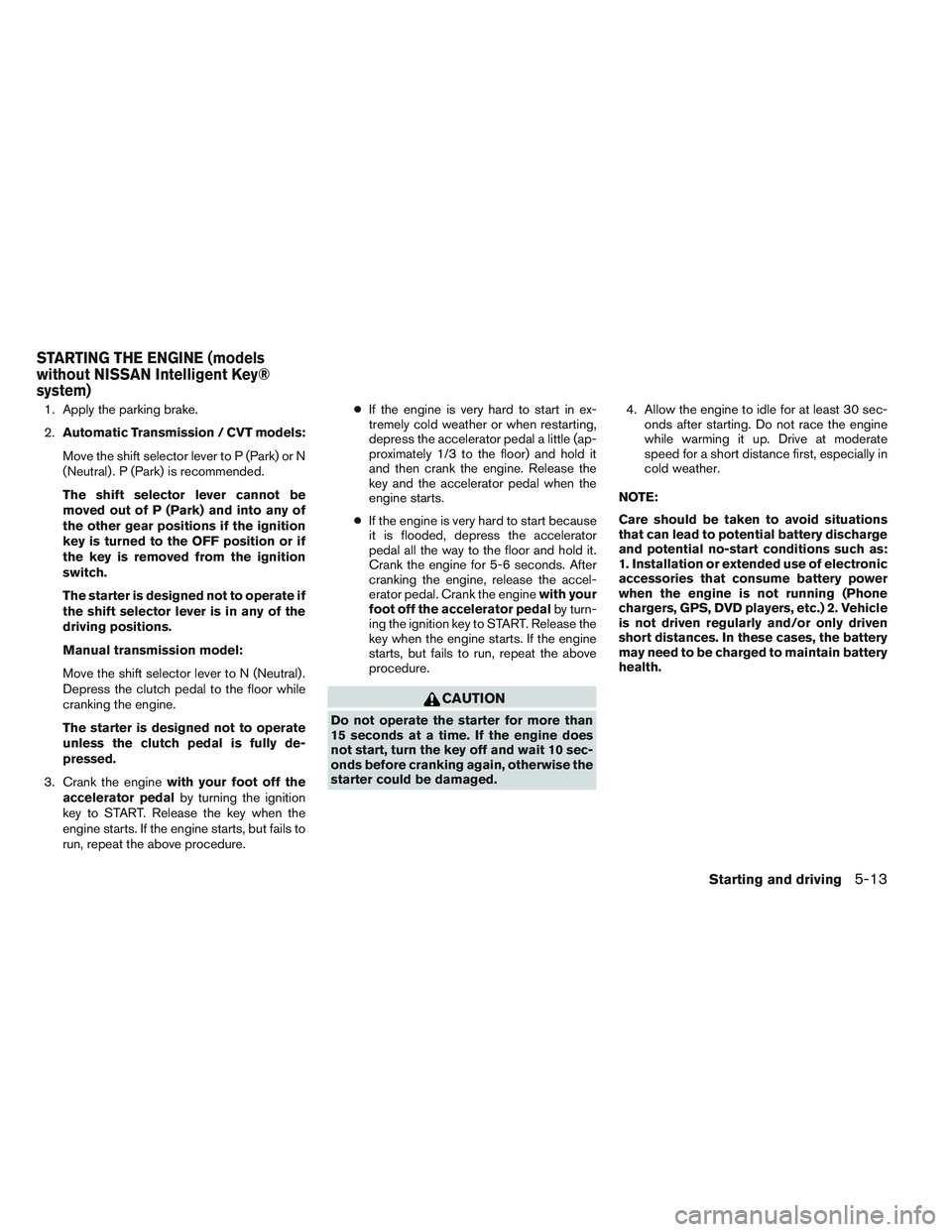
1. Apply the parking brake.
2.Automatic Transmission / CVT models:
Move the shift selector lever to P (Park) or N
(Neutral) . P (Park) is recommended.
The shift selector lever cannot be
moved out of P (Park) and into any of
the other gear positions if the ignition
key is turned to the OFF position or if
the key is removed from the ignition
switch.
The starter is designed not to operate if
the shift selector lever is in any of the
driving positions.
Manual transmission model:
Move the shift selector lever to N (Neutral) .
Depress the clutch pedal to the floor while
cranking the engine.
The starter is designed not to operate
unless the clutch pedal is fully de-
pressed.
3. Crank the engine with your foot off the
accelerator pedal by turning the ignition
key to START. Release the key when the
engine starts. If the engine starts, but fails to
run, repeat the above procedure. ●
If the engine is very hard to start in ex-
tremely cold weather or when restarting,
depress the accelerator pedal a little (ap-
proximately 1/3 to the floor) and hold it
and then crank the engine. Release the
key and the accelerator pedal when the
engine starts.
● If the engine is very hard to start because
it is flooded, depress the accelerator
pedal all the way to the floor and hold it.
Crank the engine for 5-6 seconds. After
cranking the engine, release the accel-
erator pedal. Crank the engine with your
foot off the accelerator pedal by turn-
ing the ignition key to START. Release the
key when the engine starts. If the engine
starts, but fails to run, repeat the above
procedure.
CAUTION
Do not operate the starter for more than
15 seconds at a time. If the engine does
not start, turn the key off and wait 10 sec-
onds before cranking again, otherwise the
starter could be damaged. 4. Allow the engine to idle for at least 30 sec-
onds after starting. Do not race the engine
while warming it up. Drive at moderate
speed for a short distance first, especially in
cold weather.
NOTE:
Care should be taken to avoid situations
that can lead to potential battery discharge
and potential no-start conditions such as:
1. Installation or extended use of electronic
accessories that consume battery power
when the engine is not running (Phone
chargers, GPS, DVD players, etc.) 2. Vehicle
is not driven regularly and/or only driven
short distances. In these cases, the battery
may need to be charged to maintain battery
health.
STARTING THE ENGINE (models
without NISSAN Intelligent Key®
system)
Starting and driving5-13
Page 221 of 331
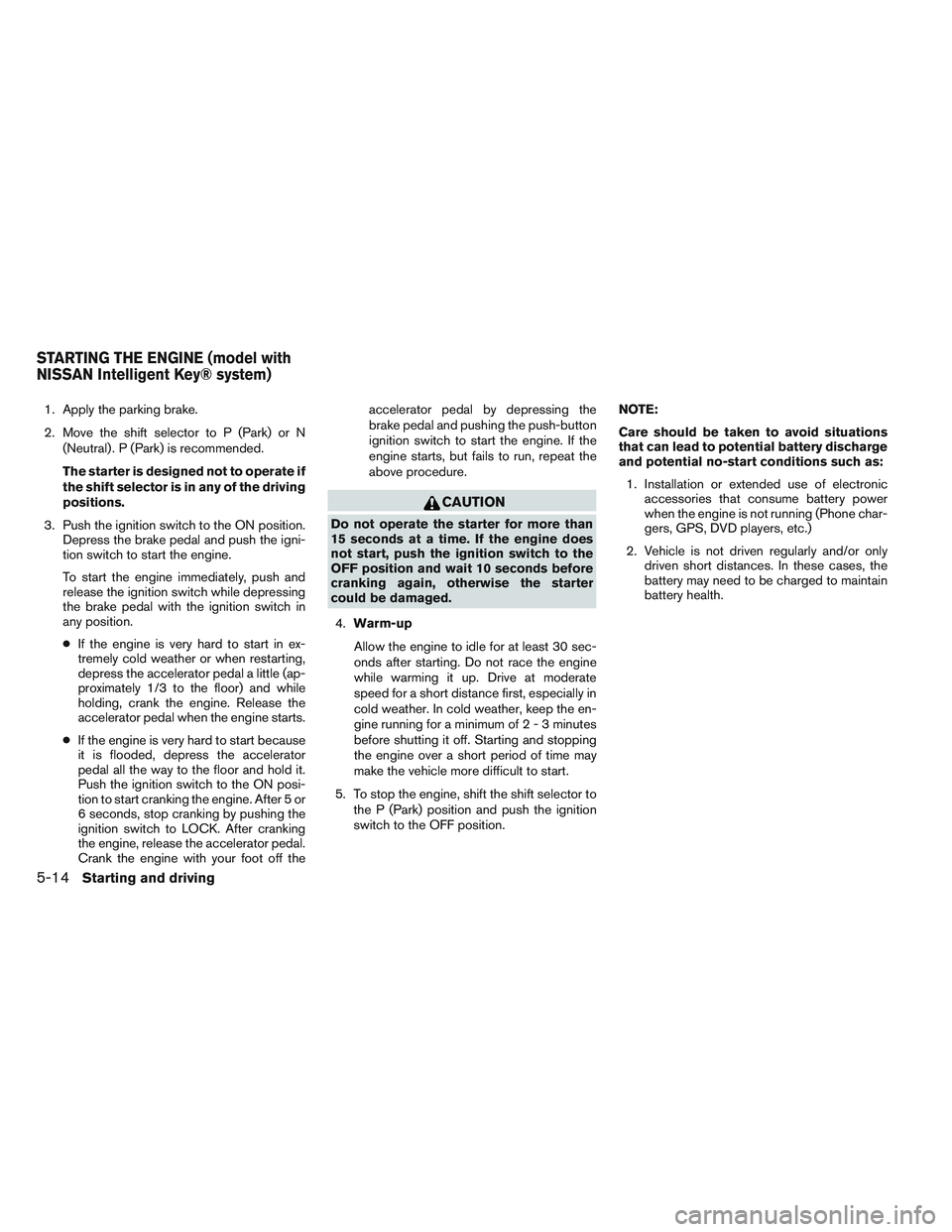
1. Apply the parking brake.
2. Move the shift selector to P (Park) or N(Neutral) . P (Park) is recommended.
The starter is designed not to operate if
the shift selector is in any of the driving
positions.
3. Push the ignition switch to the ON position. Depress the brake pedal and push the igni-
tion switch to start the engine.
To start the engine immediately, push and
release the ignition switch while depressing
the brake pedal with the ignition switch in
any position.
● If the engine is very hard to start in ex-
tremely cold weather or when restarting,
depress the accelerator pedal a little (ap-
proximately 1/3 to the floor) and while
holding, crank the engine. Release the
accelerator pedal when the engine starts.
● If the engine is very hard to start because
it is flooded, depress the accelerator
pedal all the way to the floor and hold it.
Push the ignition switch to the ON posi-
tion to start cranking the engine. After 5 or
6 seconds, stop cranking by pushing the
ignition switch to LOCK. After cranking
the engine, release the accelerator pedal.
Crank the engine with your foot off the accelerator pedal by depressing the
brake pedal and pushing the push-button
ignition switch to start the engine. If the
engine starts, but fails to run, repeat the
above procedure.
CAUTION
Do not operate the starter for more than
15 seconds at a time. If the engine does
not start, push the ignition switch to the
OFF position and wait 10 seconds before
cranking again, otherwise the starter
could be damaged.
4. Warm-up
Allow the engine to idle for at least 30 sec-
onds after starting. Do not race the engine
while warming it up. Drive at moderate
speed for a short distance first, especially in
cold weather. In cold weather, keep the en-
gine running for a minimum of2-3minutes
before shutting it off. Starting and stopping
the engine over a short period of time may
make the vehicle more difficult to start.
5. To stop the engine, shift the shift selector to the P (Park) position and push the ignition
switch to the OFF position. NOTE:
Care should be taken to avoid situations
that can lead to potential battery discharge
and potential no-start conditions such as:
1. Installation or extended use of electronic accessories that consume battery power
when the engine is not running (Phone char-
gers, GPS, DVD players, etc.)
2. Vehicle is not driven regularly and/or only driven short distances. In these cases, the
battery may need to be charged to maintain
battery health.
STARTING THE ENGINE (model with
NISSAN Intelligent Key® system)
5-14Starting and driving
Page 265 of 331
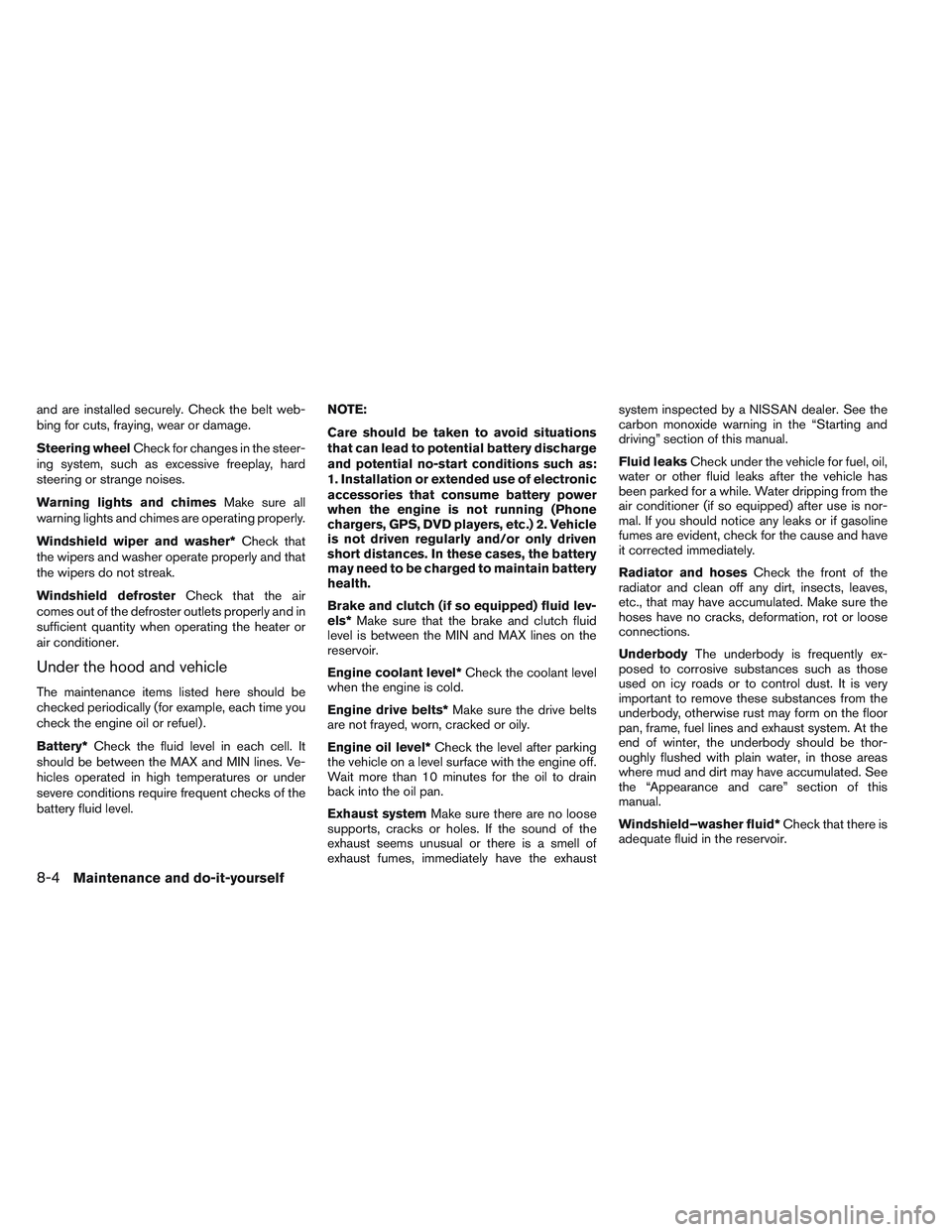
and are installed securely. Check the belt web-
bing for cuts, fraying, wear or damage.
Steering wheelCheck for changes in the steer-
ing system, such as excessive freeplay, hard
steering or strange noises.
Warning lights and chimes Make sure all
warning lights and chimes are operating properly.
Windshield wiper and washer* Check that
the wipers and washer operate properly and that
the wipers do not streak.
Windshield defroster Check that the air
comes out of the defroster outlets properly and in
sufficient quantity when operating the heater or
air conditioner.
Under the hood and vehicle
The maintenance items listed here should be
checked periodically (for example, each time you
check the engine oil or refuel) .
Battery* Check the fluid level in each cell. It
should be between the MAX and MIN lines. Ve-
hicles operated in high temperatures or under
severe conditions require frequent checks of the
battery fluid level. NOTE:
Care should be taken to avoid situations
that can lead to potential battery discharge
and potential no-start conditions such as:
1. Installation or extended use of electronic
accessories that consume battery power
when the engine is not running (Phone
chargers, GPS, DVD players, etc.) 2. Vehicle
is not driven regularly and/or only driven
short distances. In these cases, the battery
may need to be charged to maintain battery
health.
Brake and clutch (if so equipped) fluid lev-
els*
Make sure that the brake and clutch fluid
level is between the MIN and MAX lines on the
reservoir.
Engine coolant level* Check the coolant level
when the engine is cold.
Engine drive belts* Make sure the drive belts
are not frayed, worn, cracked or oily.
Engine oil level* Check the level after parking
the vehicle on a level surface with the engine off.
Wait more than 10 minutes for the oil to drain
back into the oil pan.
Exhaust system Make sure there are no loose
supports, cracks or holes. If the sound of the
exhaust seems unusual or there is a smell of
exhaust fumes, immediately have the exhaust system inspected by a NISSAN dealer. See the
carbon monoxide warning in the “Starting and
driving” section of this manual.
Fluid leaks
Check under the vehicle for fuel, oil,
water or other fluid leaks after the vehicle has
been parked for a while. Water dripping from the
air conditioner (if so equipped) after use is nor-
mal. If you should notice any leaks or if gasoline
fumes are evident, check for the cause and have
it corrected immediately.
Radiator and hoses Check the front of the
radiator and clean off any dirt, insects, leaves,
etc., that may have accumulated. Make sure the
hoses have no cracks, deformation, rot or loose
connections.
Underbody The underbody is frequently ex-
posed to corrosive substances such as those
used on icy roads or to control dust. It is very
important to remove these substances from the
underbody, otherwise rust may form on the floor
pan, frame, fuel lines and exhaust system. At the
end of winter, the underbody should be thor-
oughly flushed with plain water, in those areas
where mud and dirt may have accumulated. See
the “Appearance and care” section of this
manual.
Windshield–washer fluid* Check that there is
adequate fluid in the reservoir.
8-4Maintenance and do-it-yourself
Page 274 of 331
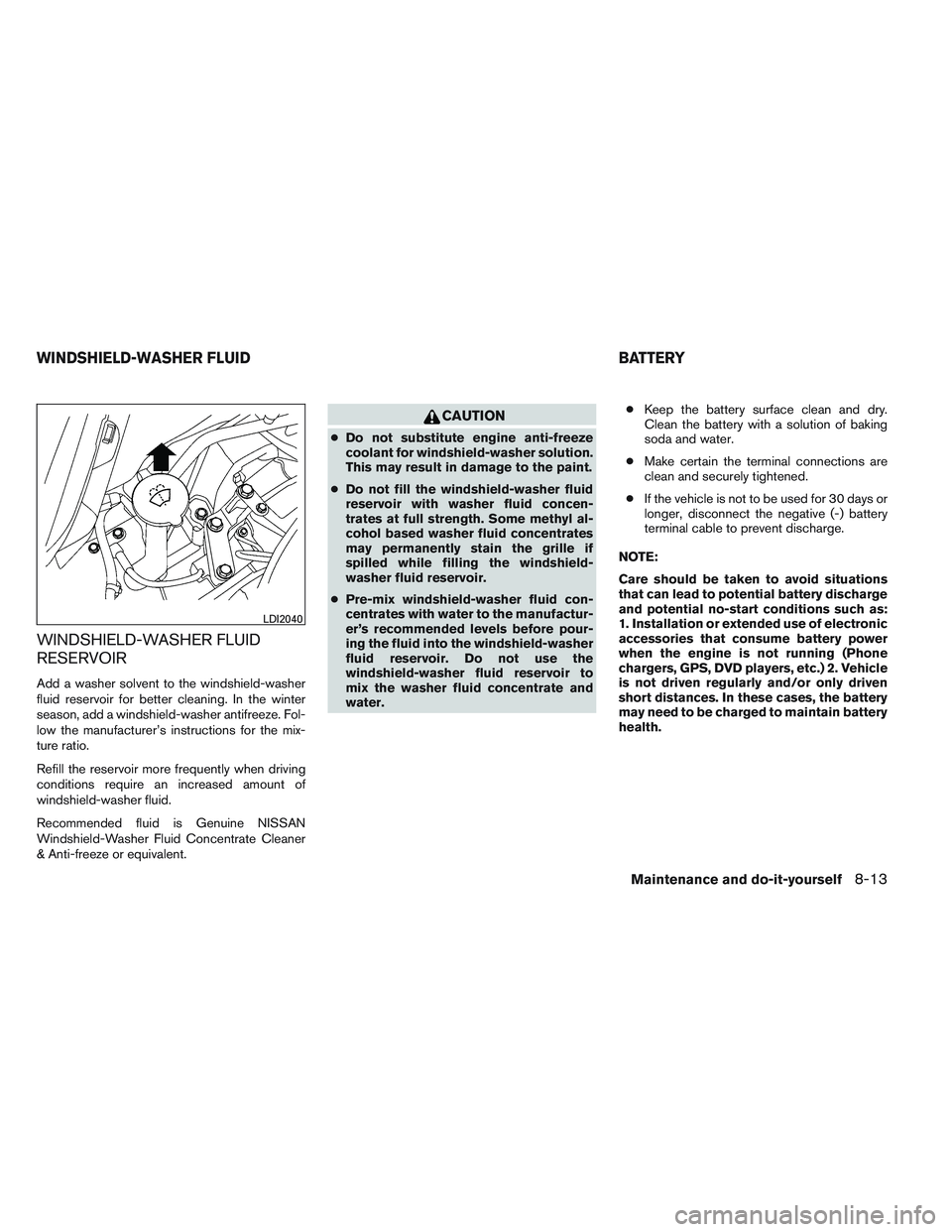
WINDSHIELD-WASHER FLUID
RESERVOIR
Add a washer solvent to the windshield-washer
fluid reservoir for better cleaning. In the winter
season, add a windshield-washer antifreeze. Fol-
low the manufacturer’s instructions for the mix-
ture ratio.
Refill the reservoir more frequently when driving
conditions require an increased amount of
windshield-washer fluid.
Recommended fluid is Genuine NISSAN
Windshield-Washer Fluid Concentrate Cleaner
& Anti-freeze or equivalent.
CAUTION
●Do not substitute engine anti-freeze
coolant for windshield-washer solution.
This may result in damage to the paint.
● Do not fill the windshield-washer fluid
reservoir with washer fluid concen-
trates at full strength. Some methyl al-
cohol based washer fluid concentrates
may permanently stain the grille if
spilled while filling the windshield-
washer fluid reservoir.
● Pre-mix windshield-washer fluid con-
centrates with water to the manufactur-
er’s recommended levels before pour-
ing the fluid into the windshield-washer
fluid reservoir. Do not use the
windshield-washer fluid reservoir to
mix the washer fluid concentrate and
water. ●
Keep the battery surface clean and dry.
Clean the battery with a solution of baking
soda and water.
● Make certain the terminal connections are
clean and securely tightened.
● If the vehicle is not to be used for 30 days or
longer, disconnect the negative (-) battery
terminal cable to prevent discharge.
NOTE:
Care should be taken to avoid situations
that can lead to potential battery discharge
and potential no-start conditions such as:
1. Installation or extended use of electronic
accessories that consume battery power
when the engine is not running (Phone
chargers, GPS, DVD players, etc.) 2. Vehicle
is not driven regularly and/or only driven
short distances. In these cases, the battery
may need to be charged to maintain battery
health.
LDI2040
WINDSHIELD-WASHER FLUID BATTERY
Maintenance and do-it-yourself8-13
Page 323 of 331
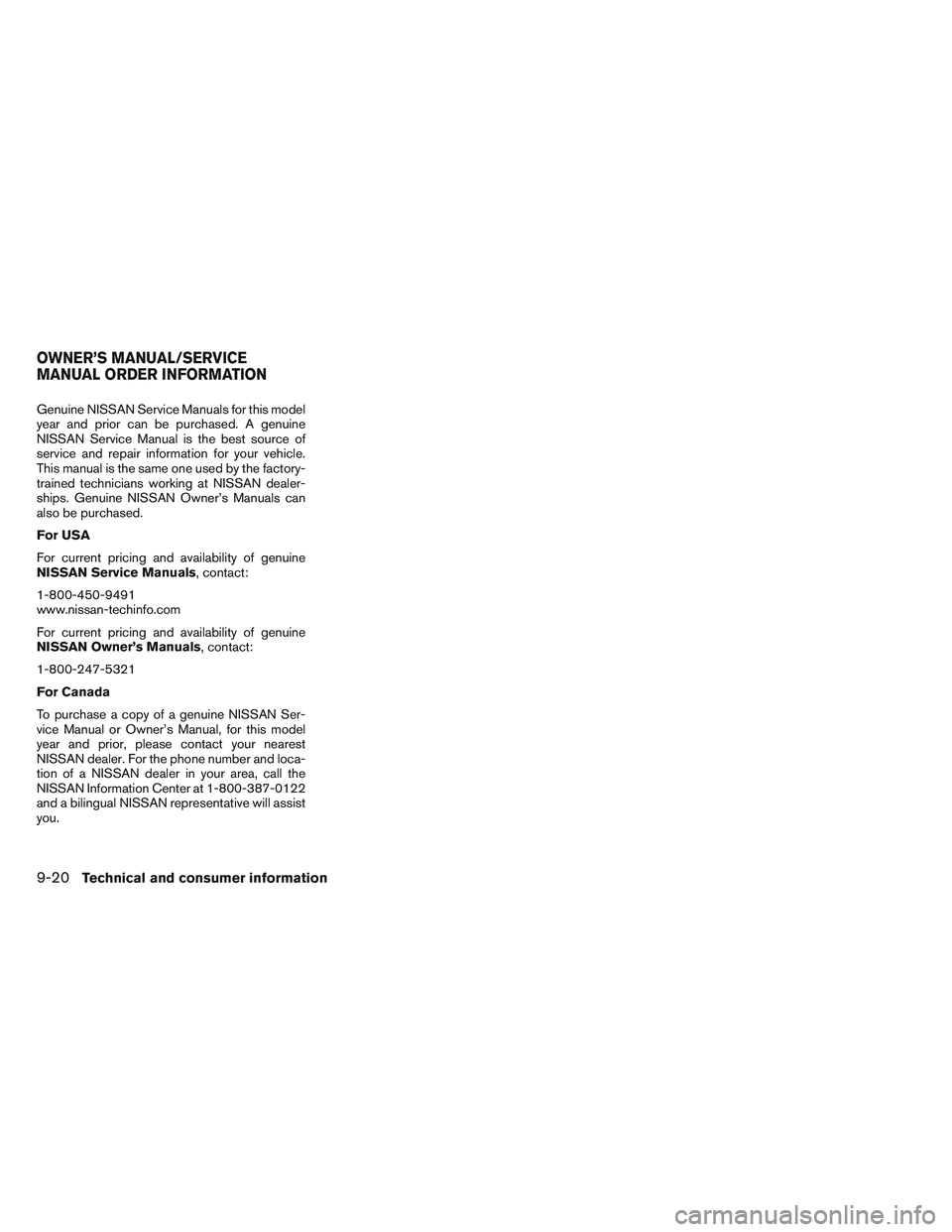
Genuine NISSAN Service Manuals for this model
year and prior can be purchased. A genuine
NISSAN Service Manual is the best source of
service and repair information for your vehicle.
This manual is the same one used by the factory-
trained technicians working at NISSAN dealer-
ships. Genuine NISSAN Owner’s Manuals can
also be purchased.
For USA
For current pricing and availability of genuine
NISSAN Service Manuals, contact:
1-800-450-9491
www.nissan-techinfo.com
For current pricing and availability of genuine
NISSAN Owner’s Manuals, contact:
1-800-247-5321
For Canada
To purchase a copy of a genuine NISSAN Ser-
vice Manual or Owner’s Manual, for this model
year and prior, please contact your nearest
NISSAN dealer. For the phone number and loca-
tion of a NISSAN dealer in your area, call the
NISSAN Information Center at 1-800-387-0122
and a bilingual NISSAN representative will assist
you.
OWNER’S MANUAL/SERVICE
MANUAL ORDER INFORMATION
9-20Technical and consumer information
Page 324 of 331
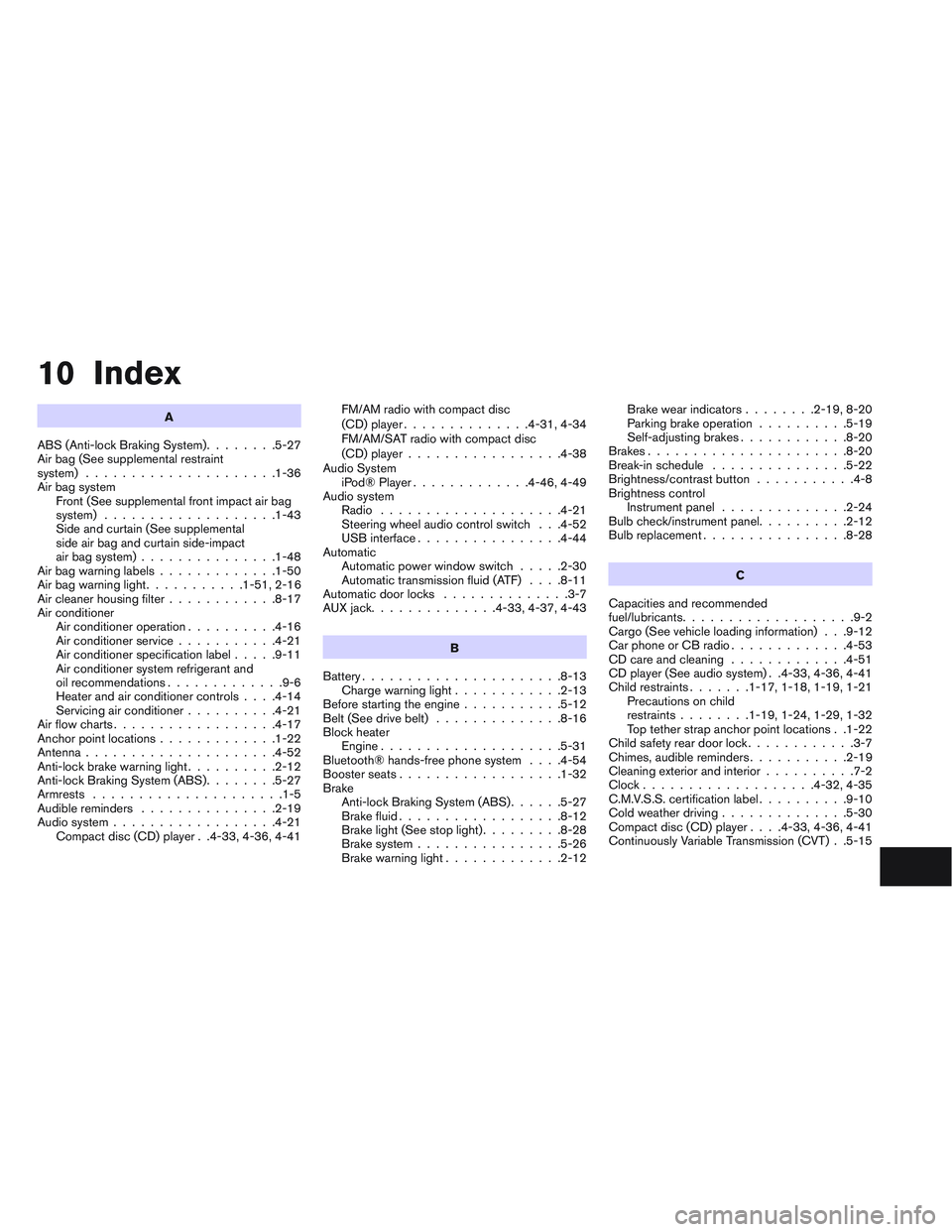
10 Index
A
ABS (Anti-lock Braking System) ........5-27
Air bag (See supplemental restraint
system) .....................1-36
Air bag system Front (See supplemental front impact air bag
system) ...................1-43
Side and curtain (See supplemental
side air bag and curtain side-impact
air bag system) ...............1-48
Airbagwarninglabels.............1-50
Airbagwarninglight...........1-51,2-16
Air cleaner housing filter ............8-17
Air conditioner Air conditioner operation ..........4-16
Air conditioner service ...........4-21
Air conditioner specification label .....9-11
Air conditioner system refrigerant and
oil recommendations .............9-6
Heater and air conditioner controls ....4-14
Servicing air conditioner ..........4-21
Airflowcharts..................4-17
Anchor point locations .............1-22
Antenna.....................4-52
Anti-lock brake warning light ..........2-12
Anti-lock Braking System (ABS) ........5-27
Armrests .....................1-5
Audible reminders ...............2-19
Audio system ..................4-21
Compact disc (CD) player . .4-33, 4-36, 4-41 FM/AM radio with compact disc
(CD) player
..............4-31,4-34
FM/AM/SAT radio with compact disc
(CD) player .................4-38
Audio System iPod®Player.............4-46,4-49
Audio system Radio ....................4-21
Steering wheel audio control switch . . .4-52
USB interface ................4-44
Automatic Automatic power window switch .....2-30
Automatic transmission fluid (ATF) ....8-11
Automatic door locks ..............3-7
AUXjack..............4-33,4-37,4-43
B
Battery ......................8-13
Chargewarninglight............2-13
Before starting the engine ...........5-12
Belt (See drive belt) ..............8-16
Block heater Engine ....................5-31
Bluetooth® hands-free phone system ....4-54
Boosterseats..................1-32
Brake Anti-lock Braking System (ABS) ......5-27
Brake fluid ..................8-12
Brake light (See stop light) .........8-28
Brake system ................5-26
Brake warning light .............2-12 Brake wear indicators
........2-19,8-20
Parking brake operation ..........5-19
Self-adjusting brakes ............8-20
Brakes ......................8-20
Break-inschedule ...............5-22
Brightness/contrast button ...........4-8
Brightness control Instrument panel ..............2-24
Bulb check/instrument panel ..........2-12
Bulbreplacement................8-28
C
Capacities and recommended
fuel/lubricants ...................9-2
Cargo (See vehicle loading information) . . .9-12
CarphoneorCBradio.............4-53
CDcareandcleaning .............4-51
CD player (See audio system) . .4-33, 4-36, 4-41
Child restraints .......1-17,1-18,1-19,1-21
Precautions on child
restraints ........1-19,1-24,1-29,1-32
Top tether strap anchor point locations . .1-22
Child safety rear door lock ............3-7
Chimes,audiblereminders...........2-19
Cleaning
exterior and interior ..........7-2
Clock...................4-32,4-35
C.M.V.S.S. certification label ..........9-10
Cold weather driving ..............5-30
Compact disc (CD) player ....4-33,4-36,4-41
Continuously Variable Transmission (CVT) . .5-15
Page 326 of 331
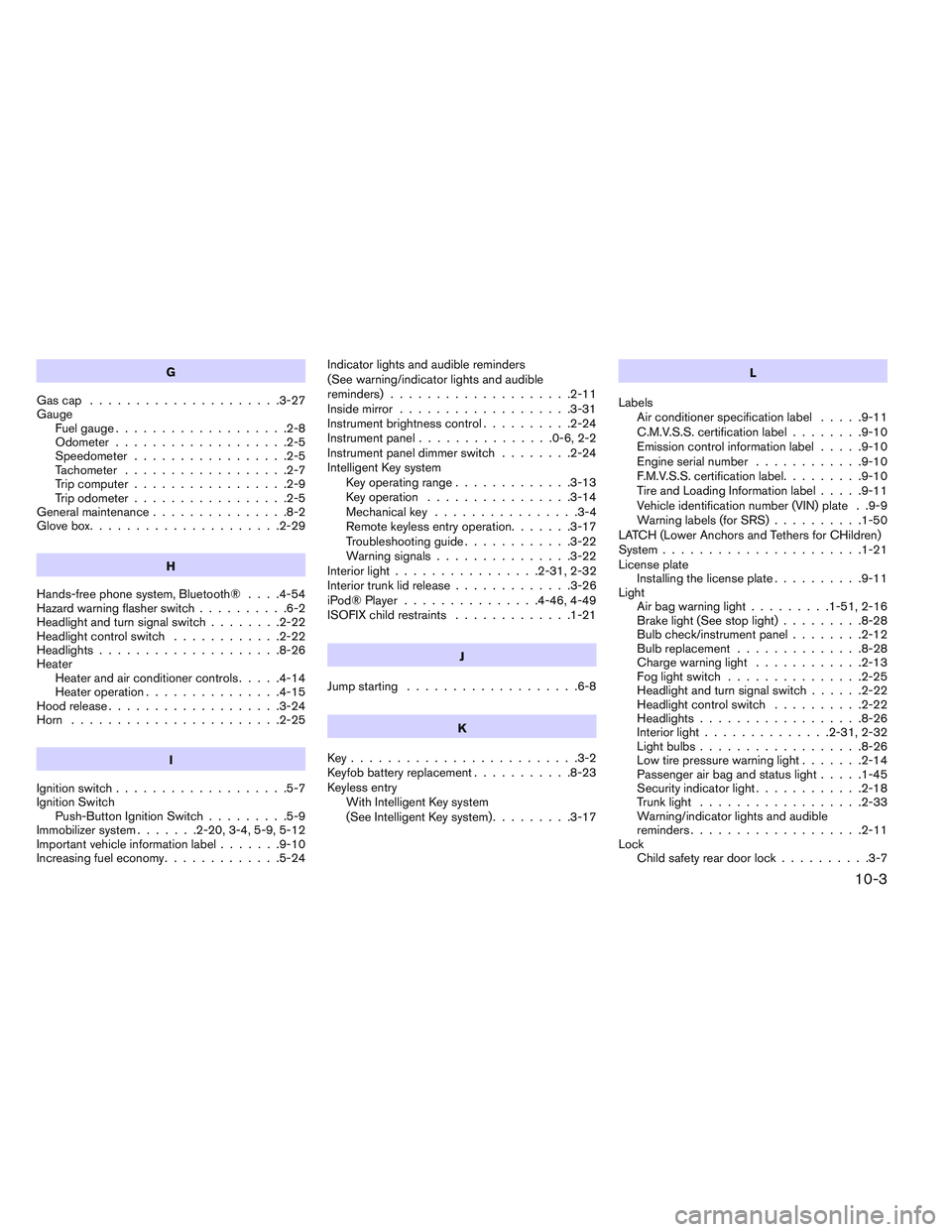
G
Gascap .....................3-27
Gauge Fuel gauge ...................2-8
Odometer ...................2-5
Speedometer .................2-5
Tachometer ..................2-7
Trip computer .................2-9
Trip odometer .................2-5
Generalmaintenance...............8-2
Glovebox.....................2-29
H
Hands-free phone system, Bluetooth® ....4-54
Hazard warning flasher switch ..........6-2
Headlightandturnsignalswitch........2-22
Headlightcontrolswitch ............2-22
Headlights....................8-26
Heater Heater and air conditioner controls .....4-14
Heater operation ...............4-15
Hood release ...................3-24
Horn .......................2-25
I
Ignition switch ...................5-7
Ignition Switch Push-Button Ignition Switch .........5-9
Immobilizer system .......2-20,3-4,5-9,5-12
Importantvehicleinformationlabel.......9-10
Increasing fuel economy .............5-24 Indicator lights and audible reminders
(See warning/indicator lights and audible
reminders)....................2-11
Inside mirror
...................3-31
Instrument brightness control ..........2-24
Instrument panel ...............0-6,2-2
Instrument panel dimmer switch ........2-24
Intelligent Key system Key operating range .............3-13
Key operation ................3-14
Mechanicalkey ................3-4
Remote keyless entry operation .......3-17
Troubleshooting guide ............3-22
Warning signals ...............3-22
Interiorlight................2-31,2-32
Interiortrunklidrelease.............3-26
iPod® Player ...............4-46,4-49
ISOFIX child restraints .............1-21
J
Jump starting ...................6-8
K
Key.........................3-2
Keyfob battery replacement ...........8-23
Keyless entry With Intelligent Key system
(See Intelligent Key system) .........3-17 L
Labels Air conditioner specification label .....9-11
C.M.V.S.S. certification label ........9-10
Emission control information label .....9-10
Engine serial number ............9-10
F.M.V.S.S. certification label .........9-10
Tire and Loading Information label .....9-11
Vehicle identification number (VIN) plate . .9-9
Warning labels (for SRS) ..........1-50
LATCH (Lower Anchors and Tethers for CHildren)
System ......................1-21
License plate Installing the license plate ..........9-11
Light Airbagwarninglight.........1-51, 2-16
Brake light (See stop light) .........8-28
Bulb check/instrument panel ........
2-12
Bulbreplacement..............8-28
Charge warning light ............2-13
Fog light switch ...............2-25
Headlightandturnsignalswitch......2-22
Headlight control switch ..........2-22
Headlights..................8-26
Interiorlight..............2-31,2-32
Lightbulbs..................8-26
Low tire pressure warning light .......2-14
Passenger air bag and status light .....1-45
Security indicator light ............2-18
Trunklight ..................2-33
Warning/indicator lights and audible
reminders...................2-11
Lock Child safety rear door lock ..........3-7
10-3